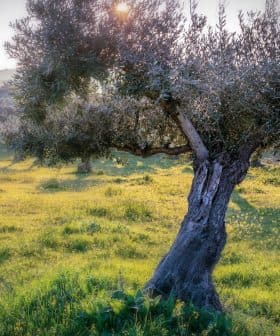 9.2K reads
9.2K readsBasics
How Oleuropein Influences Extra Virgin Olive Oil Taste and Health Benefits

Oleuropein, a major phenolic compound in extra virgin olive oil, contributes to its health benefits and flavor. The compound is produced by olive trees as a defense mechanism, acting as a quality marker throughout production and impacting sensory attributes. Oleuropein has been linked to various health benefits, including reducing blood pressure, combating inflammation, and potentially aiding in the treatment of Alzheimer’s disease, osteoporosis, and cancer.
Oleuropein, one of the major phenolic compounds found in extra virgin olive oil, is key to many olive oil health benefits and even its flavor.
The olive tree produces the compound as a defensive mechanism, its bitterness acting as a natural deterrent to pests. That same bitterness translates to a marker of quality in oil.
Oleuropein, identified as the first secoiridoid in olive oil by Panizzi et al. in 1958, is a significant component of olive polyphenols. Its presence in olives and oil varies depending on the olive variety, milling techniques and technology and storage conditions.
Secoiridoids
Secoiridoids, present in all Oleaceae plants, including olive trees, constitute the majority of bioactive polyphenols in olive oil and drupes. These compounds, characterized by cyclopentanopyran ring structures, undergo secoiridoid cleavage to produce bioactive derivatives with diverse pharmacological activities. Research indicates that secoiridoids, including those from olives, possess antioxidant and anti-inflammatory properties, potentially promoting overall health and disease prevention.
Oleuropein serves as a quality marker throughout production. The bitter, pungent taste of extra virgin olive oil primarily arises from its main phenolic compounds, including oleocanthal, hydroxytyrosol and oleuropein.
Extensive research has explored the beneficial effects of oleuropein on ailments including cancer, hypertension, heart issues and various viral and bacterial diseases.
How oleuropein impacts sensory attributes
Research conducted by Andrewes and colleagues in 2003 isolated and evaluated individual phenolic compounds present in olive oil.
They found that the compound p‑HPEA-EDA, a secoiridoid derivative of oleuropein, elicited a strong burning pungent sensation at the back of the throat, contributing significantly to the oil’s pungent attribute. In contrast, another compound, 3,4‑DHPEA-EDA, produced only a slight burning or numbing sensation, predominantly perceived on the tongue.
Further analysis using the calcium mobilization functional assay revealed that several phenolic compounds activate bitter taste receptors TAS2R1, TAS2R8 and TAS2R14.
See Also:The Flavors of Extra Virgin Olive OilLigstroside aglycon and oleuropein aglycon were identified as the most potent bitter tastants in olive oil. TAS2R8 and TAS2R1 were found to be the primary bitter taste receptors responding to phenolic compounds, with oleuropein activating TAS2R8 exclusively, albeit with lower potency compared to the algycons.
While oleuropein has low potency towards the receptor TAS2R8, research suggests that the intensely bitter sensation experienced when chewing raw olives is primarily due to the spontaneous conversion of oleuropein into aglycon forms.
Oleuropein and oleuropein glucosidase are typically found in separate cellular compartments and only come into contact when olive fruit cells are damaged, such as during chewing or crushing for oil production.
Oleuropein’s role in olive oil health benefits
Oleuropein and its derivative, hydroxytyrosol, possess potent antioxidant properties, contributing to olive oil’s reputation for combating inflammation and associated diseases.
Notably, oleuropein has demonstrated a capacity to significantly reduce blood pressure, both systolic and diastolic, in animal models, aligning with olive leaf’s traditional use in treating hypertension.
See Also:Health NewsRecent studies reveal that oleuropein’s mechanism in reducing blood pressure involves protecting the hypothalamus from oxidative stress through Nrf2-mediated signaling, offering potential as a preventive and therapeutic approach for hypertension.
Beyond blood pressure regulation, oleuropein exhibits various health-promoting functions, including cardioprotection, anti-inflammatory, antioxidant, anti-cancer, anti-angiogenic and neuroprotective effects.
Oleuropein and Alzheimer’s disease
Numerous in vitro investigations have explored the antioxidant and neuroprotective attributes of extracts from extra virgin olive oil, uncovering their therapeutic potential in combating Alzheimer’s disease.
When administered before exposure, these extracts have been shown to upregulate key antioxidant enzymes in neuroblastoma cells, mitigating oxidative damage induced by free radicals.
Phenolic compounds found in extra virgin olive oil, such as hydroxytyrosol and oleuropein, have demonstrated the ability to impede the translocation of nuclear factor kappa B (NFkB) into the nucleus, leading to diminished production of pro-inflammatory agents and thus curbing neuroinflammation driven by microglia.
See Also:Olive Oil BasicsMoreover, these compounds have been observed to enhance the secretion of anti-inflammatory cytokines while suppressing the production of pro-inflammatory cytokines, presenting a multifaceted approach to combating neuroinflammation.
In experiments using neuroblastoma cells, a combination treatment involving oleuropein aglycone and hydroxytyrosol has exhibited the activation of autophagic flux, reduction in free radical production, prevention of mitochondrial dysregulation and inhibition of cellular damage inflicted by amyloid-beta plaques.
Furthermore, interventions involving oleuropein supplementation have shown promise in enhancing cognitive functions, memory and behavioral disorders in patients with mild Alzheimer’s disease.
Oleuropein and osteoporosis
Age-related bone density loss is associated with osteoblast insufficiency during the body’s continuous bone remodeling.
Studies suggest that the formation of osteoblasts in bone marrow is closely associated with adipogenesis, the formation of adipocytes (fat cells) from stem cells and that age-related changes in this relationship could be responsible for the increasing adiposity of bone marrow associated with osteoporosis.
Puel et al. examined oleuropein’s effects on ovariectomized rats with and without inflammation, finding positive impacts on bone loss only in inflamed rats.
See Also:Consuming Oleuropein May Mitigate the Effects of Aging on Muscular AtrophyOleuropein enhances osteoblast formation while reducing adipocyte generation, suggesting preventive effects against osteoporosis and age-related bone loss.
Regarding bone resorption, oleuropein at varying concentrations decreased the formation of osteoclast-like cells in spleen cell cultures.
In vitro studies by García Martínez et al. also demonstrated that phenolic extracts from Sicilian virgin olive oil increased osteoblast cell numbers, potentially aiding bone growth.
Phenolic compounds have also been shown to modulate gene expression related to bone growth and differentiation in MG-63 osteosarcoma cells. These phenolic components benefit bone physiology, potentially protecting against bone diseases by influencing osteoblast function.
Oleuropein and cancer
Over the years, the consumption of oleuropein has been associated with aiding in cancer treatment.
This was initially attributed to its antioxidant properties, but it is now recognized that oleuropein’s impact on cancer extends beyond its antioxidant role. It functions as both an anti-proliferative and apoptotic promoter in various cancer cells, demonstrating many anticancer properties currently under investigation.
Oleuropein shows multifaceted effects in cancer. It induces apoptosis (cell death) in cervical cancer cells via JNK activation and activates ERK1/2 through GPER in breast cancer, inhibiting cell growth.
Moreover, it modulates apoptosis regulators like BAX, Bcl2 and p53, enhancing apoptotic pathways and reducing cancer cell survival.
See Also:Research Shows the Role of Polyphenols in Inhibiting Cancer MetastasisA wealth of experimental data supports HER2-induced signaling as a key player in cancer progression. HER2 overexpression, particularly in breast cancer, activates pathways like PI3K/Akt and MAPK, driving tumor growth.
While drugs like trastuzumab target HER2, resistance often develops. Oleuropein aglycone synergizes with trastuzumab in breast cancer cells, inhibiting HER2 proteolytic processing and downregulating its expression, offering a promising therapeutic approach.
Combining oleuropein with AKT inhibitors enhances apoptosis, particularly in cells overexpressing AKT. Oleuropein also impacts ROS levels, reducing them in thyroid cancer cells while increasing them in prostate cancer cells, suggesting cell-specific effects. Additionally, it downregulates NF-κB and cyclin D1, inhibiting oncogenic pathways in breast cancer.
Researchers believe that future studies should explore oleuropein’s in vivo effects on redox status across various cancer stages and microenvironments. Understanding these dynamics could lead to the development of targeted anticancer therapies.
Know the Basics
Things to know about olive oil, from the Olive Oil Times Education Lab.
Extra virgin olive oil (EVOO) is simply juice extracted from olives without any industrial processing or additives. It must be bitter, fruity and pungent — and free of defects.
There are hundreds of olive varieties used to make oils with unique sensory profiles, just as many varieties of grapes are used in wines. An EVOO can be made with just one variety (monovarietal) or several (blend).
Extra virgin olive oil contains healthy phenolic compounds. Substituting a mere two tablespoons of EVOO per day instead of less healthy fats has been shown to improve health.
Producing high-quality extra virgin olive oil is an exceptionally difficult and costly task. Harvesting olives earlier retains more nutrients and extends shelf life, but the yield is far less than that of fully ripe olives that have lost much of their healthy compounds.










